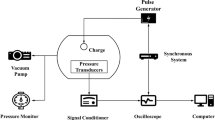Abstract
We conducted a series of numerical simulations to understand the effect of the initiation process of cylindrical high explosives on the blast-wave behavior and peak overpressure distribution. The first case involved the explosion of a cylindrical high explosive whose length-to-diameter ratio was equal to 2 and that was vertically placed above the ground surface. The initiation point was at the top of the high explosive. The initiation process induced the detonation momentum directed from top to bottom, and the detonation products forcefully hit the ground surface, resulting in a higher peak overpressure on the ground surface in comparison with the case using an isothermal constant-pressure volume. After the blast wave expanded far from the initiation point, the computed peak overpressures of the two approaches showed good agreement with those from experiments. The second case involved the explosion of a cylindrical high explosive whose length-to-diameter ratio was unity and that was placed in air. The initiation point was the one end side of the high explosive. The blast wave was divided into three regions that originated from the detonation in the high explosive, an oblique shock wave in air, and a bridge wave connected with them, thus causing an azimuthal distribution of peak overpressure. The highest peak overpressure values were computed in the bridge wave region. To understand the propagation behavior of the blast wave, we should thoroughly observe how and when all the waves affecting the blast-wave behavior are generated and how they propagate and interact with each other.












Similar content being viewed by others
References
Ouchterlony, F., Sanchidrián, J.A.: A review of development of better prediction equations for blast fragmentation. J. Rock Mech. Geotech. Eng. 11, 1094–1109 (2019). https://doi.org/10.1016/j.jrmge.2019.03.001
Sun, J., Jia, Y., Yao, Y., Xie, X.: Experimental investigation of stress transients of blasted RC columns in the blasting demolition of buildings. Eng. Struct. 210, 110417 (2020). https://doi.org/10.1016/j.engstruct.2020.110417
Lees, F.P.: Lees’ Loss Prevention in the Process Industries, 4th Edition: Hazard Identification, Assessment and Control. Butterworth-Heinemann (2012). https://doi.org/10.1016/C2009-0-24104-3
Manca, D.: Quantitative assessment in safety reports of the consequences from the detonation of solid explosives. J. Loss Prev. Process Ind. 26, 974–981 (2013). https://doi.org/10.1016/j.jlp.2013.10.010
Kingery, C.N., Bulmash, G.: Air blast parameters from TNT spherical air burst and hemispherical surface burst. Technical report ARBRL-TR-02555, U.S. Army Ballistic Research Laboratory (1984)
Baker, W.E.: Explosions in Air. University of Texas Press, Austin (1973)
Stoner, R.G., Bleakney, W.: The attenuation of spherical shock waves in air. J. Appl. Phys. 19, 670–678 (1948). https://doi.org/10.1063/1.1698189
Esparza, E.D.: Spherical equivalency of cylindrical charges in free-air. Volume I. Minutes of the Twenty-Fifth Explosives Safety Seminar, Anaheim, USA, pp. 403–428. Department of Defense Explosives Safety Board (1992)
Simoens, B., Lefebvre, M.: Influence of the shape of an explosive charge: quantification of the modification of the pressure field. Cent. Eur. J. Energ. Mater. 12, 195–213 (2015)
Needham, C., Brisby, J., Ortley, D.: Blast wave modification by detonator placement. Shock Waves 30, 615–627 (2020). https://doi.org/10.1007/s00193-020-00958-9
Artero-Guerrero, J., Pernas-Sánchez, J., Teixeira-Dias, F.: Blast wave dynamics: the influence of the shape of the explosive. J. Hazard. Mater. 331, 189–199 (2017). https://doi.org/10.1016/j.jhazmat.2017.02.035
Knock, C., Davies, N.: Blast waves from cylindrical charges. Shock Waves 23, 337–343 (2013). https://doi.org/10.1007/s00193-013-0438-7
Homae, T., Sugiyama, Y., Matsumura, T., Wakabayashi, K.: Azimuthal characteristics on blast wave from a cylindrical charge—small scale experiment. Mater. Res. Proc. 13, 53–56 (2019). https://doi.org/10.21741/9781644900338-9
Johnson, C., Mulligan, P., Williams, K., Langenderfer, M., Heniff, J.: Effect of explosive charge geometry on shock wave propagation. AIP Conf. Proc. 1979, 150021 (2018). https://doi.org/10.1063/1.5044977
Knock, C., Davies, N., Reeves, T.: Predicting blast waves from the axial direction of a cylindrical charge. Prop. Expl. Pyro. 40, 169–179 (2015). https://doi.org/10.1002/prep.201300188
Kleine, H., Dewey, J.M., Ohashi, K., Mizukaki, T., Takayama, K.: Studies of the TNT equivalence of silver azide charges. Shock Waves 13, 123–138 (2003). https://doi.org/10.1007/s00193-003-0204-3
Sugiyama, Y., Homae, T., Matsumura, T., Wakabayashi, K.: Numerical investigations on detonations in a condensed-phase explosive and oblique shock waves in surrounding fluids. Combust. Flame 211, 133–146 (2020). https://doi.org/10.1016/j.combustflame.2019.09.025
Petitpas, F., Saurel, R., Franquet, E., Chinnayya, A.: Modelling detonation waves in condensed energetic materials: multiphase CJ conditions and multidimensional computations. Shock Waves 19, 377–401 (2009). https://doi.org/10.1007/s00193-009-0217-7
Schoch, S., Nikiforakis, N., Lee, B.J., Saurel, R.: Multi-phase simulation of ammonium nitrate emulsion detonations. Combust. Flame 160, 1883–1899 (2013). https://doi.org/10.1016/j.combustflame.2013.03.033
Kapila, A.K., Schwendeman, D.W., Bdzil, J.B., Henshaw, W.D.: A study of detonation diffraction in the ignition-and-growth model. Combust. Theory Model. 11, 781–822 (2007). https://doi.org/10.1080/13647830701235774
Lee, E.L., Tarver, C.M.: Phenomenological model of shock initiation in heterogeneous explosives. Phys. Fluids 23, 2362–2372 (1980). https://doi.org/10.1063/1.862940
Toro, E.F., Spruce, M., Speares, W.: Restoration of the contact surface in the HLL-Riemann solver. Shock Waves 4, 25–34 (1994). https://doi.org/10.1007/BF01414629
Zhang, X., Shu, C.-W.: Maximum-principle-satisfying and positivity-preserving high-order schemes for conservation laws: survey and new developments. Proc. R. Soc. A 467, 2752–2776 (2011). https://doi.org/10.1098/rspa.2011.0153
Shu, C.-W., Osher, S.: Efficient implementation of essentially non-oscillatory shock-capturing schemes. J. Comput. Phys. 77, 439–471 (1988). https://doi.org/10.1016/0021-9991(88)90177-5
Sugiyama, Y., Wakabayashi, K., Matsumura, T., Nakayama, Y.: On the azimuth angle characteristics of the blast wave from an underground magazine model (I)—experiment with a magazine of small ratio of the length to the inner diameter. Sci. Technol. Energ. Mater. 77, 136–141 (2016)
Esparza, E.D.: Blast measurements and equivalency for spherical charges at small scaled distances. Int. J. Impact Eng. 4, 23–40 (1986). https://doi.org/10.1016/0734-743X(86)90025-4
Acknowledgements
This work was supported by JSPS KAKENHI Grant No. JP18K04643.
Author information
Authors and Affiliations
Corresponding author
Additional information
Communicated by C. Needham.
Publisher's Note
Springer Nature remains neutral with regard to jurisdictional claims in published maps and institutional affiliations.
Rights and permissions
About this article
Cite this article
Sugiyama, Y., Homae, T., Matsumura, T. et al. Numerical study on the effect of the initiation process of cylindrical high explosives on the blast-wave behavior. Shock Waves 31, 427–438 (2021). https://doi.org/10.1007/s00193-021-01021-x
Received:
Accepted:
Published:
Issue Date:
DOI: https://doi.org/10.1007/s00193-021-01021-x




